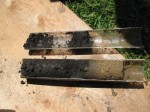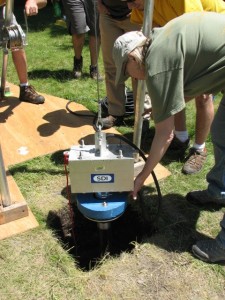During this month’s excavations in downtown Plymouth, our team set up test pits across two site locations with the goal of locating intact seventeenth and eighteenth century deposits. However, we often reached the limit of how deep we could safely dig without hitting either our target time period or sterile subsoil. Sometimes we even hit the water table while still finding nineteenth century deposits. Could it be possible that there were still earlier artifacts preserved by the damp conditions deeper in the ground? To find out, we brought in a vibracore.
A vibracore is a specialized piece of equipment that is used to take deep soil cores from waterlogged environments such as ponds or marshes. It consists of a clear tube and a small battery-powered motor. When turned on, the vibracore vibrates as it digs into the ground, helping to loosen the soil for sampling. These samples can then be analyzed for things like pollen counts or soil stratigraphy. For our project, we used the vibracore to quickly venture deeper into pits that we could no longer reasonably excavate on our own. We wanted to see if there were any soil changes or artifacts that would point to an earlier buried ground surface.
Using the vibracore was a team effort, and everyone had their job: guiding the core, pushing it down into the pit, venturing headfirst into the pit to cap the sample, and hoisting the heavy core back up again. After an unsuccessful morning of attempted coring, we were finally able to extract four progressively deeper soil cores from STP 13, ultimately allowing us to see down to 1.9 meters, or a little over six feet, below the surface.
The four soil cores that we obtained from STP 13 contained a dark soil rich with coal ash. The few artifacts we found (brick, ceramics, and glass) continued to be no earlier than the nineteenth century. Even at 1.9 meters (more than 6 feet), well below the current water level of Jenney Pond, we did not locate sterile subsoil or a previous ground surface. While this is not what we had hoped to find, the vibracore was able to give us a better understanding of the site’s subterranean topography–the lots at Jenney Pond are much more urban-like than suburban, with many deep deposits and complex filling and refilling episodes. Moving forward, we will need to consider this carefully in planning any further excavations at the site.
By Drew Webster
PS — One of our traditions is writing poems about aspects of our fieldwork. Drew composed this haiku about the results of the coring:
Searching for Pilgrims
Two meters under the ground
Still just dumb coal ash.






April 16, 2014 at 2:20 PM
Nice job.
I knew you were trying to use the Vibecore for land work even if it was designed for water applications. We did not realize the challenge you faced. A very nice application we certianly did not have in mind when we designed this equipment. Its always a pleasure to see the many different applications. My compliments!